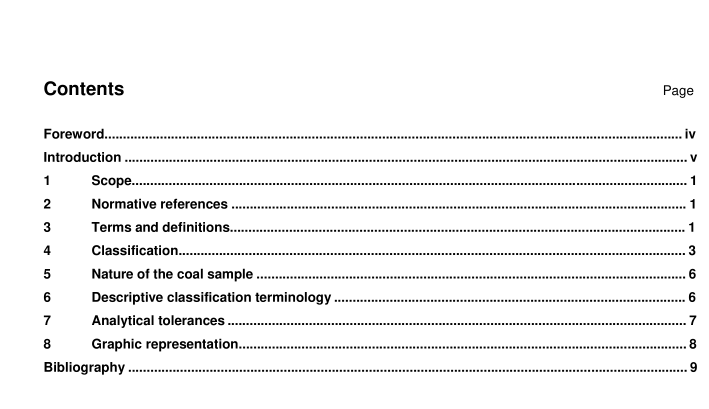BS ISO 11760 pdf download

BS ISO 11760 pdf download Classification of coals
This International Standard describes a simple classification system for coals providing
guidance on the selection of the appropriate ISO standard procedures for the analyses and testing ofcoals,
international comparison of coals in terms of some key characteristics
descriptive categorization of coals.
The system is applicable to coals of all ranks, but care is required in relation to the classification of some typesof coal.
The system may be applied to a wide range of representative coal samples, provided their exact nature isstated. Such samples include bore-core seam sections and composite samples, raw (as-mined) coal, washedcoal, blends of coals of similar rank and selected, specified size fractions.
The systemm provides a broad framework within which coals can be assessed. The selection of coals for aspecific use requires detailed information that enables the likely performance of a coal in a particularapplication to be anticipated. he wide-ranging list of ISO analyses and test procedures for coals serve thispurpose. The selection of the appropriate procedures to be used in assessing a coal depends on the intendeduse.
2 Normative references
The following referenced documents are indispensable for the application of this document. For datedreferences, only the edition cited applies. For undated references, the latest edition of the referenceddocument (including any amendments) applies.
ISO 1213-2,Solid mineral fuels — Vocabulary — Part 2: Terms relating to sampling, testing and analysisISO 7404-1, Methods for the petrographic analysis of bituminous coal and anthracite — Part 1: VocabularyISO 7404-5,Methods for the petrographic analysis of bituminous coal and anthracite — Part 5: Method ofdetermining microscopically the reflectance of vitrinite
3 Terms and definitions
For the purposes of this document, the terms and definitions given in ISO 1213-2, ISO 7404-1 and thefollowing apply.
3.1
coal
carbonaceous sedimentary rock largely derived from plant remains with an associated mineral contentcorresponding to an ash yield less than, or equal to, 50 % by mass (dry basis)
NOTE In the geological coalification sequence, the transformation from peat to coal is defined as occurring when the total in-situ moisture content has decreased to 75 % by mass. The upper limit for undisturbed coal seams in the normal coalification process leading to semi-graphite is defined as corresponding to a mean random vitrinite reflectance, R r , of 6,0 % or, preferably, a mean maximum vitrinite reflectance, R v, max , of 8 %, determined in accordance with ISO 7404-5. The upper limit, R v, max , for disturbed, contact altered, coals can exceed 1 0 %; see Table 1 , Note 2.
3.2
vitrinite
group of macerals with a grey colour (as observed with reflected light under a microscope) and with a reflectance generally between that of the associated darker liptinite and lighter inertinite over the rank range in which the three respective maceral groups can be readily recognized









